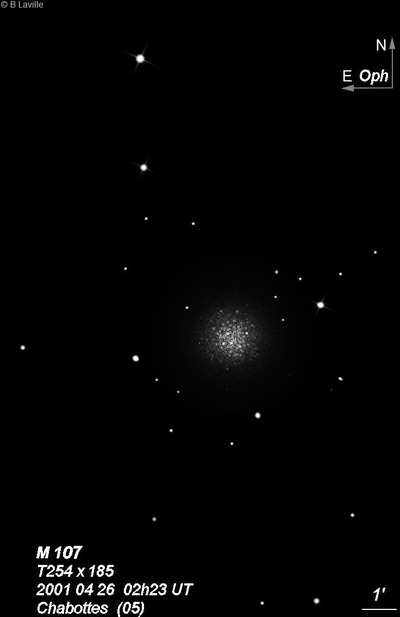
15x50 IS binoculars: faint but not difficult.
Pierre Méchain discovered M107 = NGC 6171 = H VI-40 = h3637 in April 1782. It was discovered after Messier's final catalogue was sent to publication but was included in a letter dated 6 May 1783 to Johann Bernoulli, the editor of the Berliner Astronomisches Jahrbuch and published in the 1786 Jarbuch volume. Mechain wrote "In April 1782 I discovered a small nebula in the left flank of Ophiuchus between the stars Zeta and Phi, the position of which I have not yet observed any closer." This was the last of Mechain's discoveries.
William Herschel rediscovered the globular on 12 May 1793 (sweep 1043) and called it "a very beautiful extremely compressed cluster of stars, extremely rich, R, about 5 or 6' dia, gradually more compressed toward the center." It was found again by Karl Harding around 1823 and reported as new. John Herschel, observing from the Cape of Good Hope on 5 Jun 1836, recorded "Globular; v rich; gpmbM; diam in RA = 20.0s; that of the most compressed part 4.5s; stars well separated."
200/250mm - 8" bright core, fainter halo, mottled. A few stars are visible at the northwest edge.
300/350mm - 13" (6/19/82): bright core with several faint stars resolved in the halo and a few stars resolved at the edge of the core.
400/500mm - 17.5" (7/10/99): this bright globular was well resolved at 220x, with a ~5'x3' halo elongated in an E-W orientation although the sharply defined core is circular and ~2' in diameter. Enclosing the globular on the west, east and south sides are brighter mag 11.5-12.5 stars. Roughly 30 stars are scattered throughout the outer halo at 280x and a couple of dozen densely packed stars overlay the core of the globular in steady moments.
Notes by Steve Gottlieb